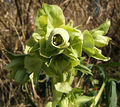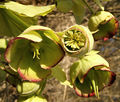Helleborus foetidus
Jump to navigation
Jump to search
APG IV Classification: Domain: Eukaryota • (unranked): Archaeplastida • Regnum: Plantae • Cladus: Angiosperms • Cladus: eudicots • Ordo: Ranunculales • Familia: Ranunculaceae • Subfamilia: Ranunculoideae • Tribus: Helleboreae • Genus: Helleborus • Species: Helleborus foetidus L. (1753)

Wikispecies has an entry on:
- English: Stinking Hellebore, Dungwort
- aragonés: Ixarruego
- العربية: خربق كريه الرائحة
- مصرى: خربق كرية الرائحه
- asturianu: pitallón
- català: Marxívol
- čeština: čemeřice smrdutá, Čemeřice smrdutá
- Cymraeg: Crafanc-yr-arth Ddrewllyd
- dansk: Stinkende nyserod
- Deutsch: Stinkende Nieswurz
- dolnoserbski: Smjerźecy kichac
- American English: setterwort
- español: Eléboro fétido
- euskara: otsababa ar
- فارسی: کنگرگون
- suomi: Haisujouluruusu
- français: Hellébore fétide, ellébore fétide
- hornjoserbsce: Smjerdźaca čemjerca
- italiano: Elleboro puzzolente
- 日本語: コダチクリスマスローズ
- kernowek: kraban an ors flerys
- Nederlands: Stinkend nieskruid, stinkend nieskruid
- polski: Ciemiernik cuchnący
- slovenčina: Čemernica smradľavá
- slovenščina: Smrdljivi teloh
- svenska: Klockjulros
- Türkçe: Kokuşuk çöpleme
- 中文: 臭铁筷子, 臭嚏根草
Species
[edit]Habitus - leaves
[edit]-
Plant with inflorescence and flower buds
-
Inflorescence with flower buds
-
Leaves
Flora / Flowers
[edit]-
Port del Comte (Solsonès - Catalunya)
-
A Pinós (Solsonès - Catalunya)
-
A Torà (Segarra - Catalunya)
-
Port del Comte (Solsonès - Catalunya)
-
Some plants have flowers which are strongly margined with maroon-purple
-
Hellebore flowers normally have no true petals: the apparent petals are sepals or "tepals"
-
If the flower is opened, the tubular nectaries can be seen behind the pollen-bearing stamens
-
The horn-shaped nectaries are petals which have been transformed into tubes to hold nectar
-
Stamens and nectaries soon drop, allowing the carpels to swell with fertile seed
Distribution
[edit]-
Distribution in Italy
-
Slika 18. Smrdljivi teloh. (Helléborus foetidus.), Naše škodljive rastline (1892)



























































